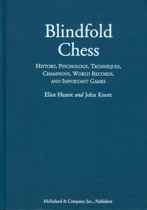Blindfold Chess
History, Psychology, Techniques, Champions, World Records, and Important Games
Eliot Hearst, John Knott

Chess fans regularly ask me questions about blindfold chess. They want to know if its only for grandmasters, they want to know if practicing this form of chess will help their ability to calculate accurately and deeply, they want to know who was the best blindfold player of all time they want to know everything you can imagine about this mysterious form of the game.
There was a time when I would dread these questions since getting answers (definitive answers and not just opinions) was far from easy. Now all that has changed Im delighted to have any excuse to open the pages of Eliot Hearsts and John Knotts magnificent opus on the subject, Blindfold Chess: History, Psychology, Techniques, Champions, World Records, and Important Games.
What a wonderful book! A very handsome hardback with library binding, it sports dozens of fascinating photos (Topalov and Judit Polgar playing blindfold, an old drawing of Philidor playing blindfold at Parsloes Chess Club in London in the 1780s, a photo of Harrwitz playing blindfold in the mid-1800s, a drawing of Paulsen giving a blindfold simultaneous in the 1860s, a very detailed drawing of Morphy giving an 8 board simul at the legendary Café de la Regence in 1858, and on an on it goes, with photos and drawings of luminaries like Steinitz, Chigorin, Lasker, Capablanca, Tartakower, Bogoljubow, Samisch, Pillsbury, Reti, Alekhine
Part One (History) offers these chapters: 1 Even Before Philidor 2 Francois-Andre Philidor 3 Between Philidor and the Late 1800s 4 The First Part of the Twentieth Century 5 The Last Fifty Years 6 Women and Blindfold Chess 7 Major Recent Tournaments and Matches
Part Two (over 50 pages on the psychology of blindfold chess) has: 8 Research on General Chess Skill 9 Psychological Studies and Commentaries on Blindfold Chess 10 The Techniques of Blindfold Champions 11 The supposed Health Hazards
Part Three is the games section, which gives no less than a staggering 444 fully annotated blindfold games by famous practitioners of the art.
But it doesnt end there! An Afterword follows, then Appendix A (World Record Blindfold Simultaneous Exhibitions Since 1782 an extraordinary addition that gives the date, place, opponents, and individual results), Appendix B (Proposed Rules for Serious Simultaneous Blindfold Displays), a huge Bibliography, a Games Index, an Index of Traditional Openings, an Openings Index by ECO Codes, an Illustrations Index, and last but certainly not least, a General Index (this covers names, terms, diseases, and just about anything you can imagine).
My favorite part of the book is the history, which takes me to places Ive never been to in my lifelong explorations of the legends of the game. Heres are two short samples (both on page 63):
“Savielly Tartakover tells the story of Reti and Alekhine analyzing together in their heads a position that arose during the London International Congress 1922. Their analysis led to quite different evaluations, and Alekhine said to Reti: Since we are, of course, the two best blindfold players in the world, I think it would be better if we had recourse to a chessboard and men where the players would presumably proceed more quickly and clearly. But their blindfold analysis had been correct, although their evaluations of the final position still differed.
“Hooper and Whyld (1992) report that Kostic visited almost every state in the US, taking on local champions in matches, and specializing in blindfold displays. After 1919 his main base of operation was Yugoslavia, but he continued his world travels and played in China, India, and many other countries. Hooper and Whyld mention that he was a member of four Yugoslav Olympic teams from 1925 to 1937 and that he usually appeared at those events in a threadbare jacket and worn-out shoes, causing the organizers to provide him with a new wardrobe!
Blindfold Chess is one of the best chess books Ive ever seen, and it justifiably won the Kramer Award for best chess book in 2009. In my view, this is something that should be in every players library if he has any interest at all in chess history. Easy to read, compelling and fun, its so rich in fascinating information that it literally blows ones mind. Both Eliot Hearst and John Knott deserve my deepest congratulations for this magnificent achievement.
